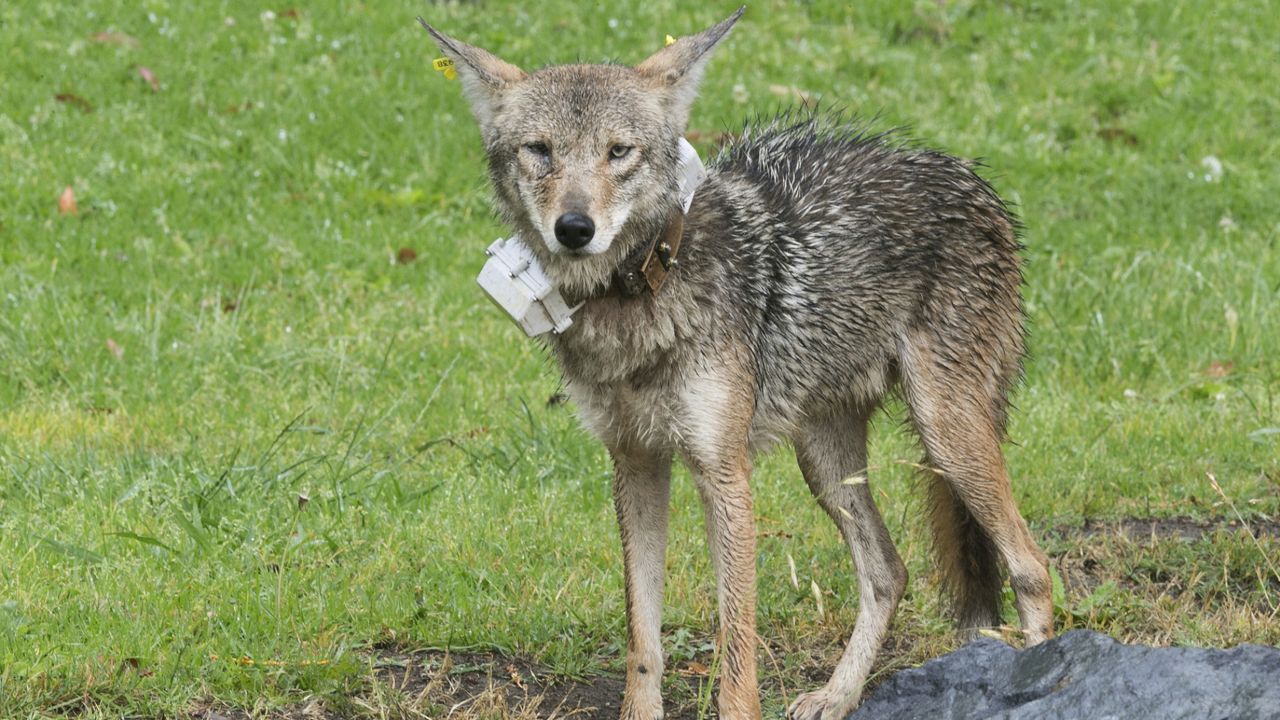REDONDO BEACH, Calif. — On December 10, Thais Amaral and her father had taken their family dog, Max, on a late-night walk of the Redondo Beach greenbelt, on the northern half of the city. They were just south of Artesia Boulevard, one of the city’s busiest thoroughfares, and turned their heads away from Max for just a moment when they heard him cry out.
In that split-second, two coyotes approached Max, and one lunged for his neck. The Amarals spun around when they heard their dog cry out.
“My dad started clapping and kicking, and he was able to punch the coyote on the side of his face,” forcing the attacking animal to back off, she said. The coyote turned and advanced on Amaral’s father but thought better of it, and the pair of coyotes turned tail.
Max survived, with only a few puncture wounds. But this is the second time the Amarals faced a coyote attack in Redondo — eight years earlier, their dog was taken when a coyote leaped over a fence and snatched it in the night.
“We know their way of attacking is very sneaky…but it was the first time I physically saw a coyote attack,” Amaral said.
Researchers believe that there’s been an expansion in coyote density, and therefore coyote sightings, in both Los Angeles County and Orange County in recent years.
There are dueling schools of thought regarding the recent growth, whether coyotes have always been in the Southland or if they’ve moved westward to expand their territory.
“But it doesn’t really matter where they came from, because they’re not going anywhere,” said Niamh Quinn, a Human-Wildlife Interactions Adviser with the University of California’s Division of Agriculture and Natural Resources. She’s part of a team focused on tracking coyote-human interactions,and educating professionals and local leaders on how to control coyotes.
Quinn believes that there’s been an increase in coyote density in recent years, in part because there’s an abundance of habitat and food. “And if they’re not increasing in density, they’re at least increasing their range across cities,” Quinn said.
Coyotes, she said, are survivors — they’re opportunistic and generalists, happy to eat anything that comes into their path. In coyote autopsies, Quinn’s seen everything from crawdads and turtles to jewels, furniture, baseballs, and garden gloves.
They’re especially fond of prey like cats, rabbits, and rats — all of which can be found in abundance in Southern California’s urban environment.
UC ANR’s Coyote Cacher tool tracks and maps self-reported interactions between humans and coyotes. The reports run the gamut from simple coyote sightings to attacks on humans and animals. According to Quinn, there have been 10 reported coyote-on-human attacks this year; since February 2017, there have been 949 reports of pets killed.
It’s difficult to manage policy regarding coyotes, Quinn said, because of the wildly disparate responses residents have. “Some citizens are OK with living with coyotes, some are not, and those citizens live next door to each other. That becomes really problematic to manage,” Quinn said. But the greatest problems occur, she said, when cities aren’t taking action.
Following an increase in reported coyote activity in 2016, the City of Torrance developed a coyote management plan with four principles: that human safety is the priority; that preventive practices are key; that solutions must address problematic behaviors from both humans and coyotes; and that residents must play a part for any program to be a success.
“I really will credit the community; there has been an excellent level of communication from our residents to report coyotes to us and help our mapping process,” said Torrance’s Community Services Director, John La Rock.
As part of the city’s coyote management program, Torrance has posted messaging throughout its parks, telling residents how to report coyote encounters, how to haze and scare off coyotes, and what not to do when they see a coyote. The city has also established a 24-hour hotline and hired a part-time coyote management expert as part of its efforts. In 2019, Torrance also established a five-month trapping season between October and March. Fourteen coyotes were trapped and euthanized during that period.
La Rock said that in the first two weeks of December, Torrance has had about 17 coyote reports, which he considers a low number for a city covering 20 square miles. “Happily, we’ve had no reported attacks of other animals. That’s good news, but we know [of coyotes as] a present condition of the community and one we want to address if at all possible,” La Rock said.
Torrance’s policy focuses on educating its residents but also has a tiered response to coyote reports. The lowest tiers of basic coyote sightings encourage residents to haze the coyotes, training them to avoid humans, with loud noises, bright lights, shouting, or throwing objects. At higher tiers, where coyotes are aggressive or violent toward humans or pets, Torrance will work to trap and lethally remove coyotes.
“But people have to understand: you can’t kill your way out of this,” Quinn said. “They’re non-game animals, which means they can be controlled by any legal means. The problem is, when you start to lethally control coyotes, all you get is coyotes from other areas.”
What helps, Quinn said, is keeping coyotes from having potential food sources. In many cases, that means not leaving food out for feral cats. Research shows that coyotes are highly-attracted to feral cat colonies. That solution, she acknowledged, could be considered inhumane.
“But what’s really inhumane is a cat being ripped apart by a coyote,” Quinn said.
Amaral said that she and her family have completely changed their own behaviors. They’ll never walk Max with fewer than two people; they’re never walking him at night again; and they’re never letting him off-leash, even for a moment.
They’re even considering walking with clubs and bear spray — not just for Max’s protection, but for their own.
